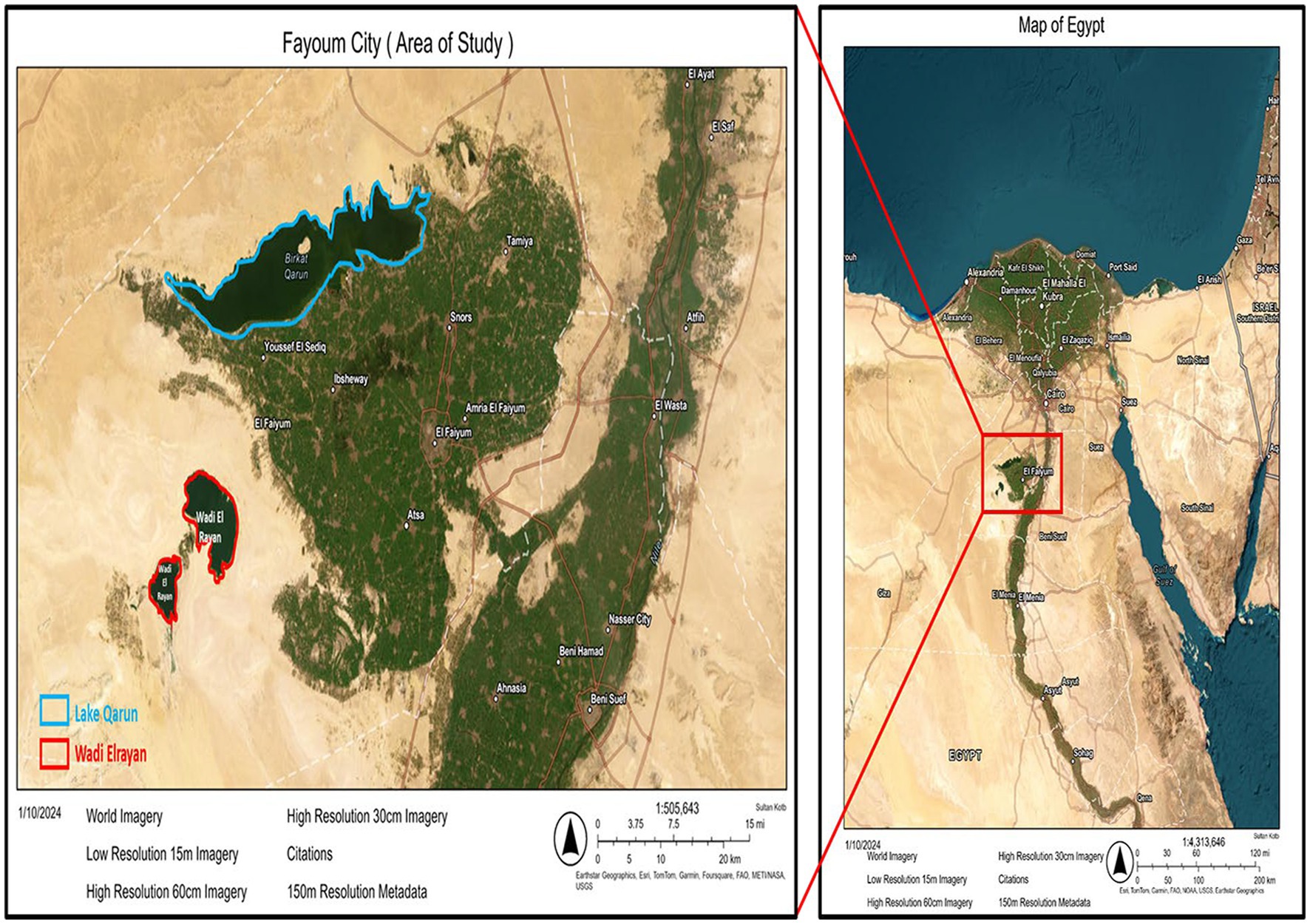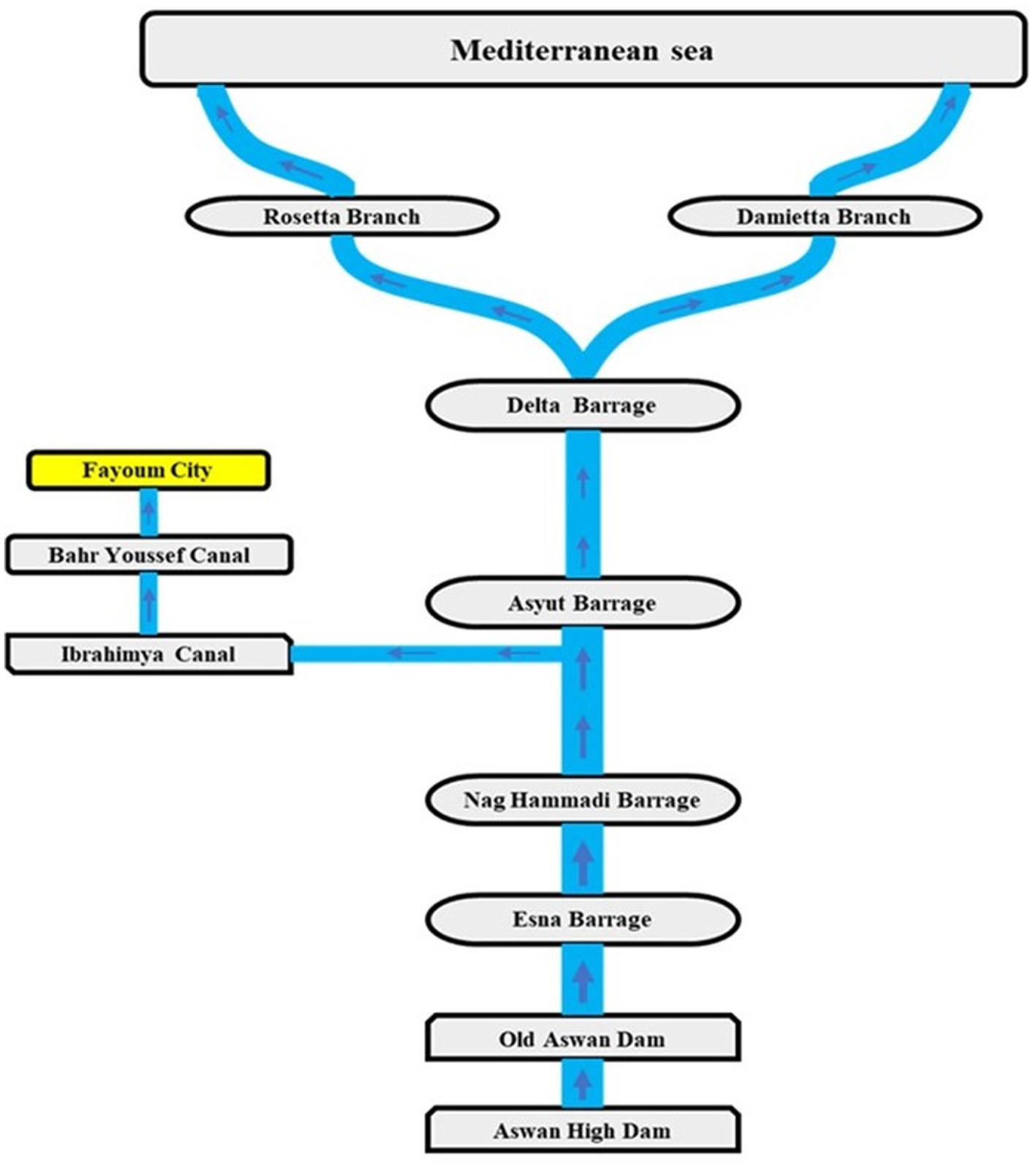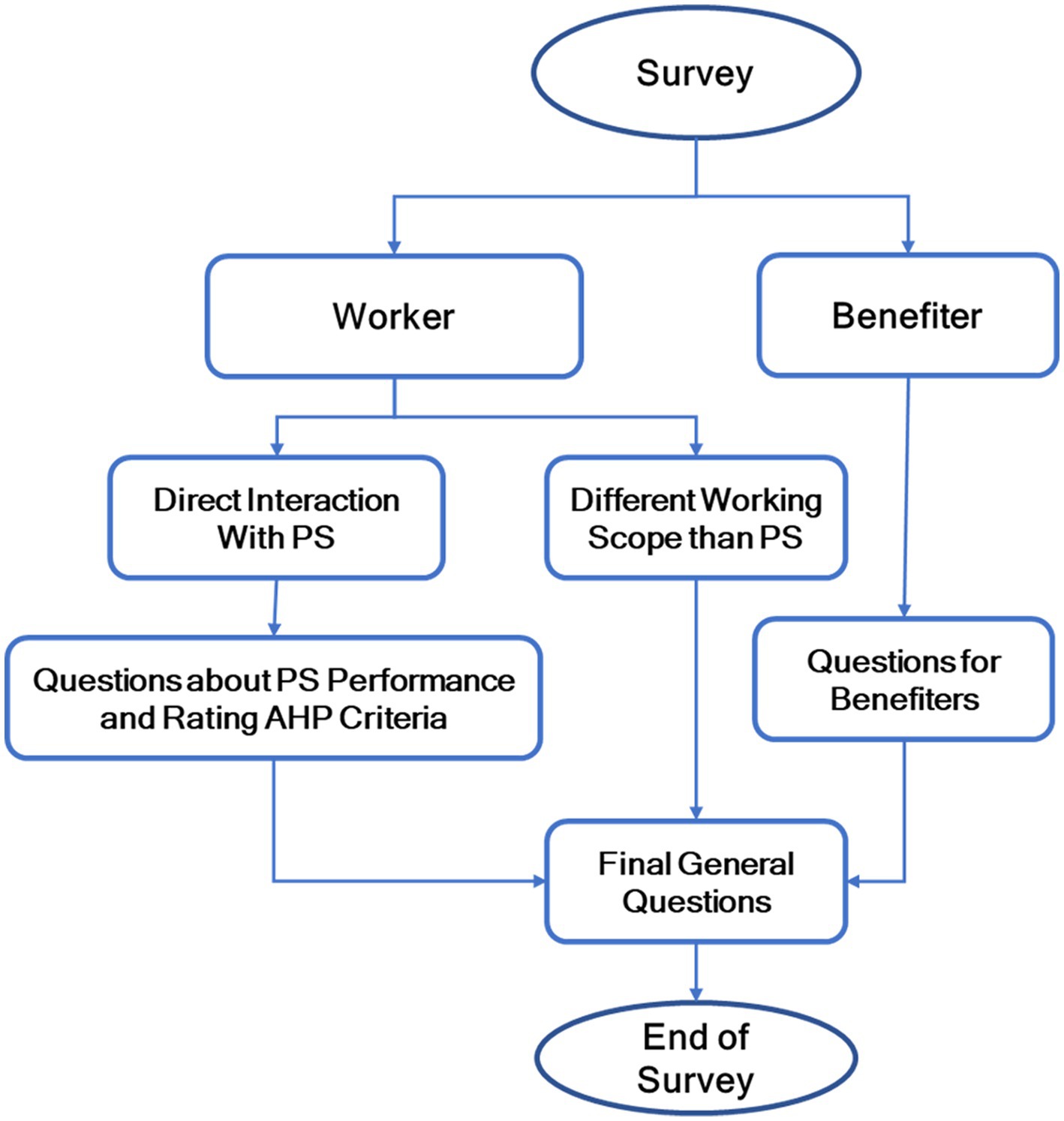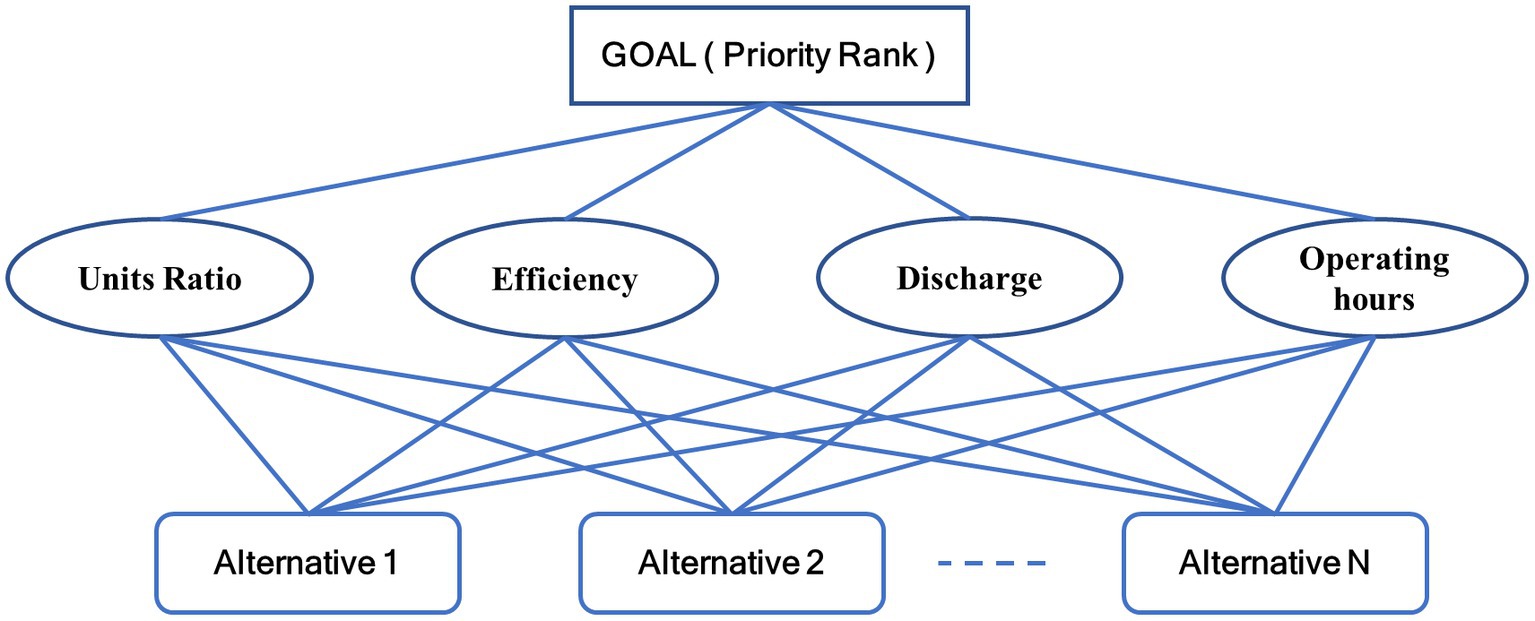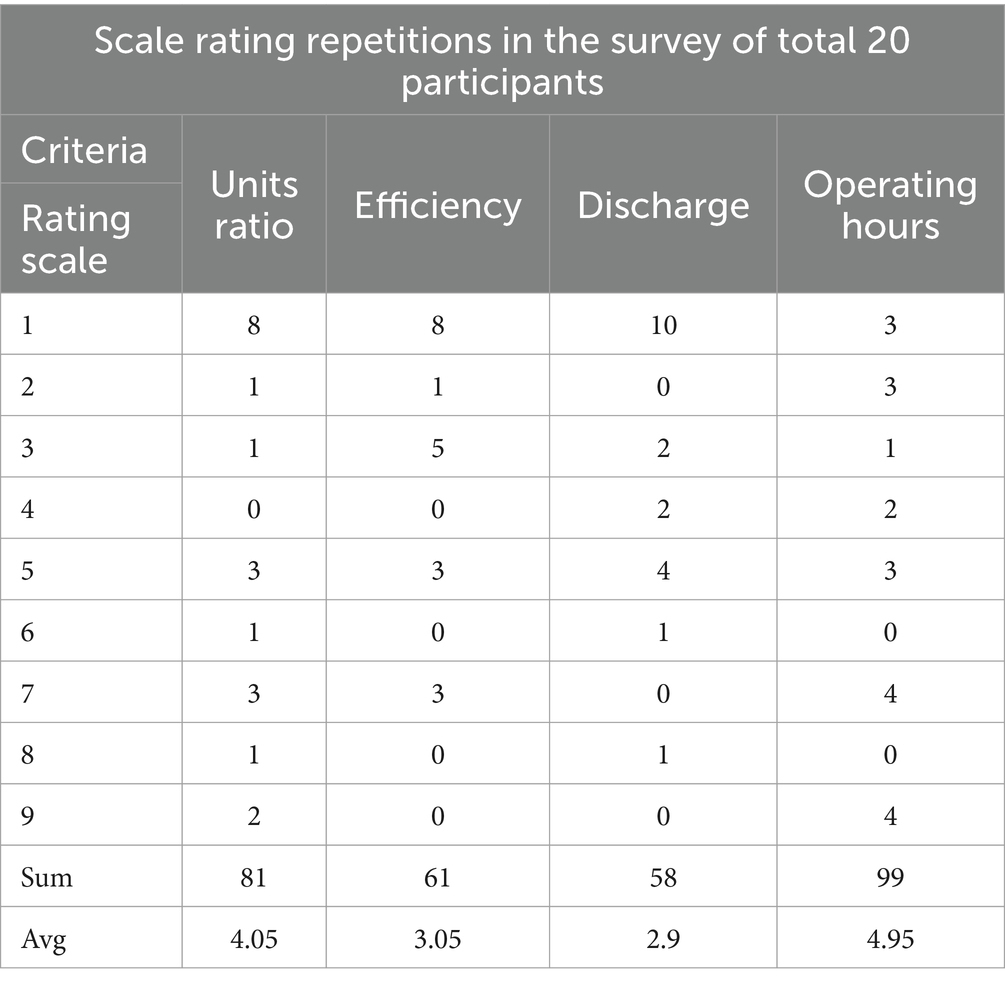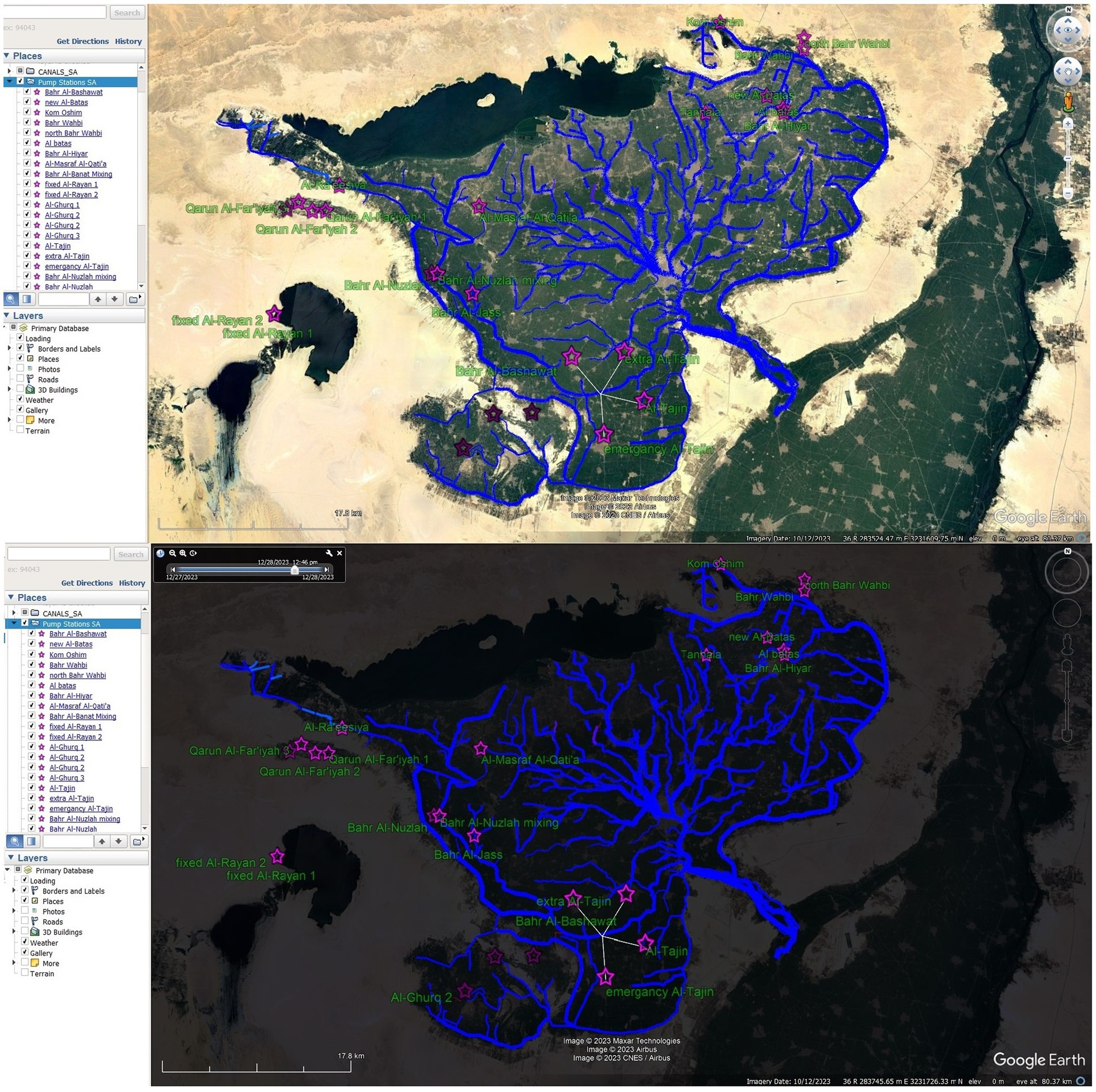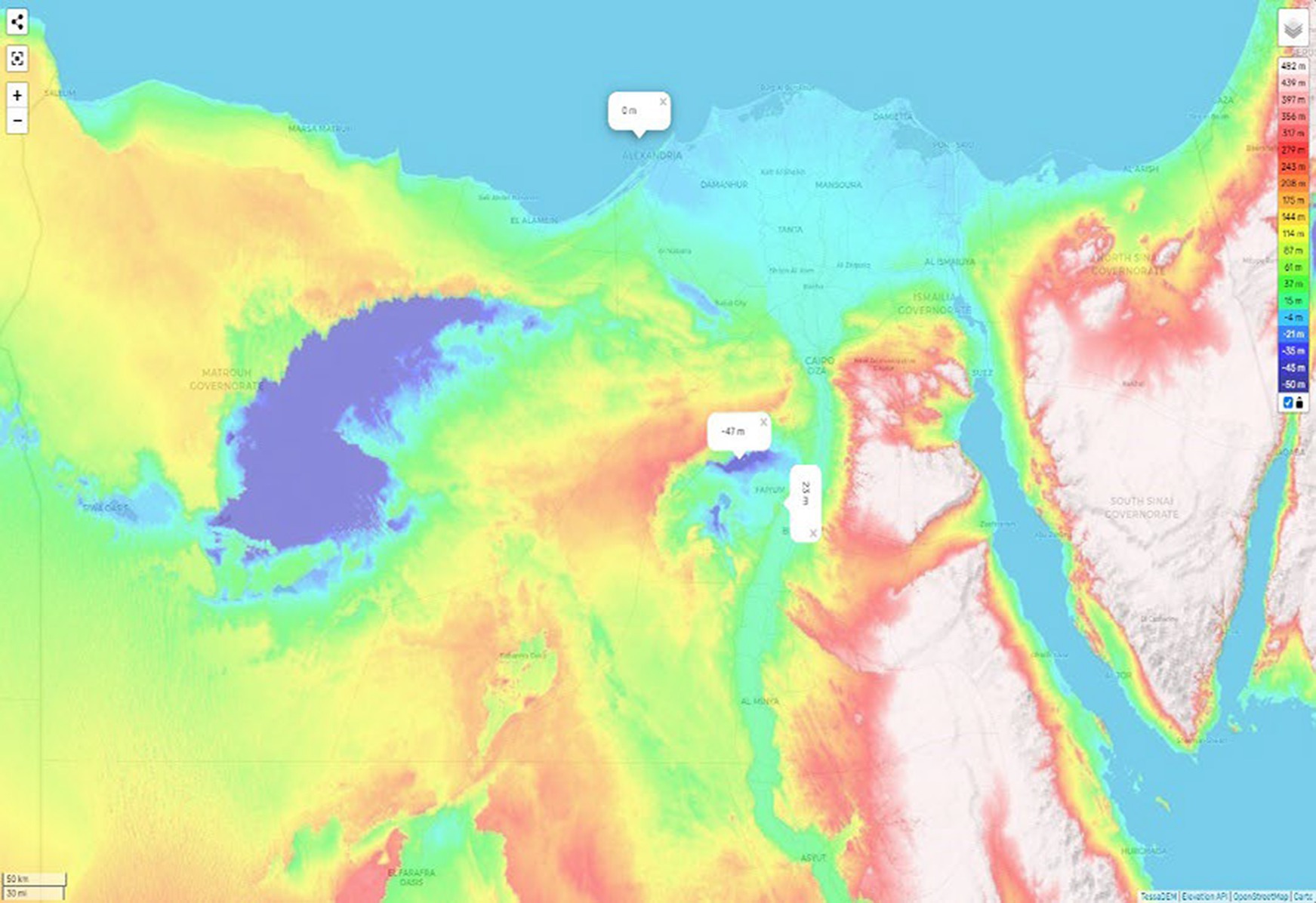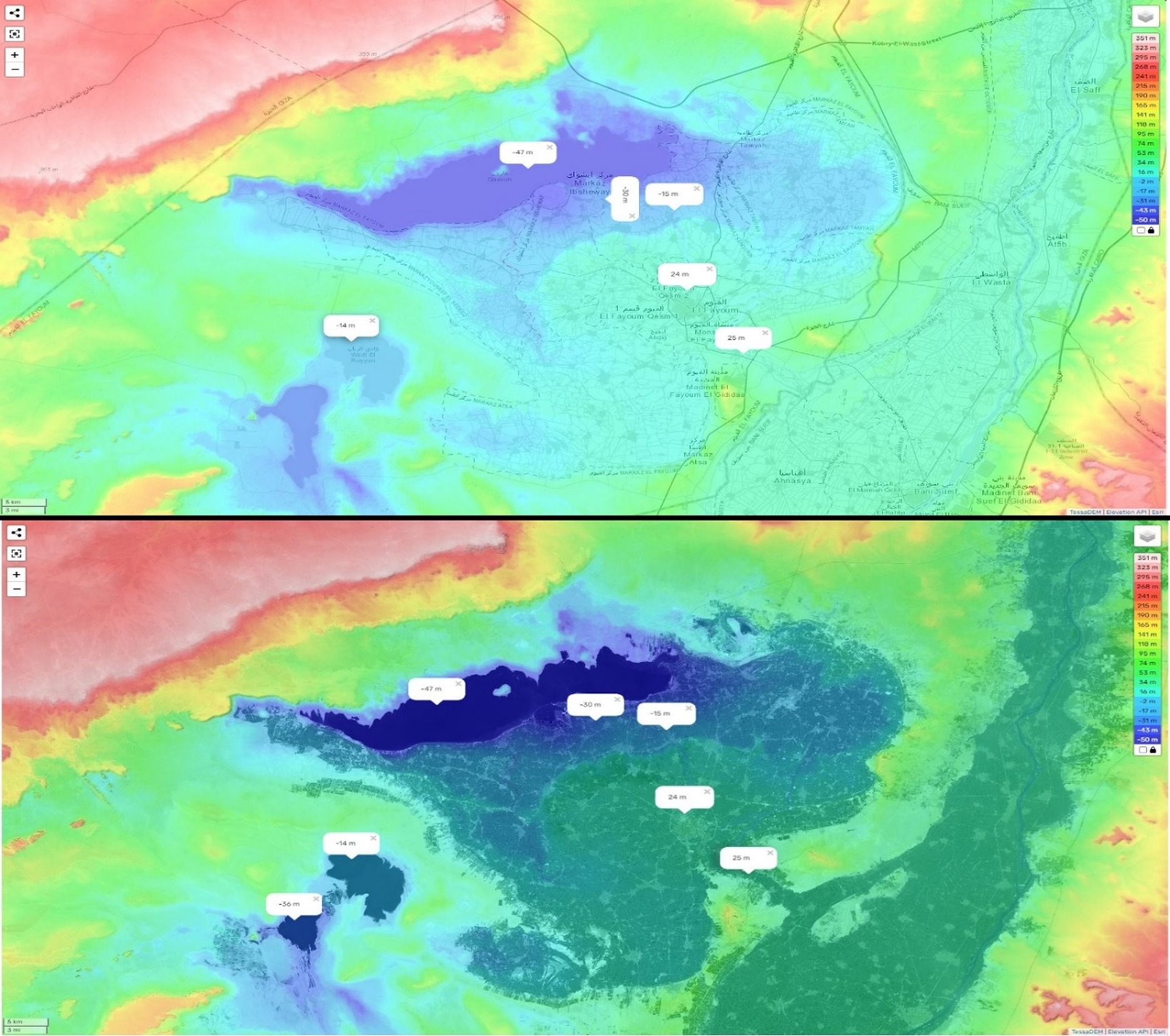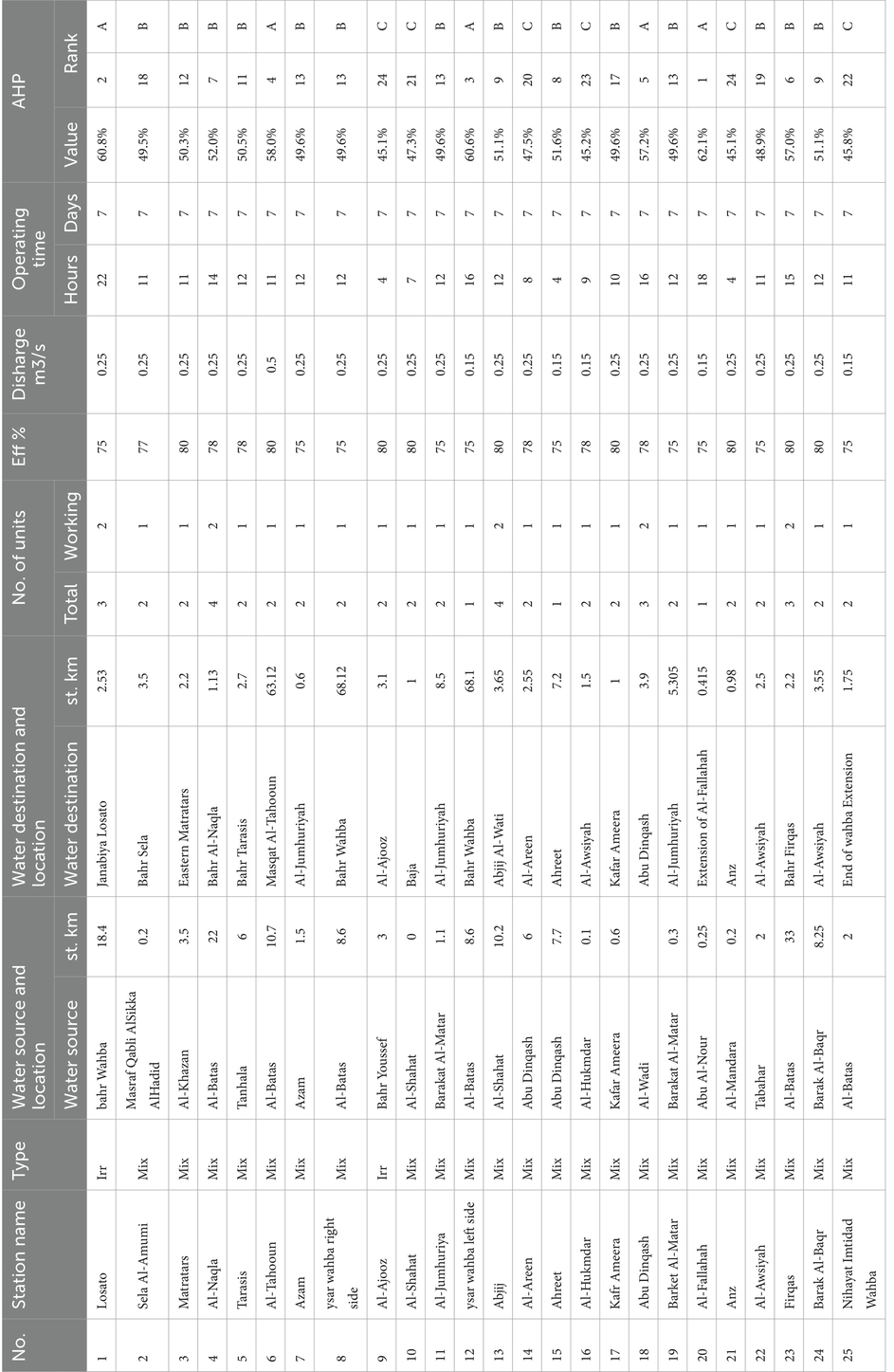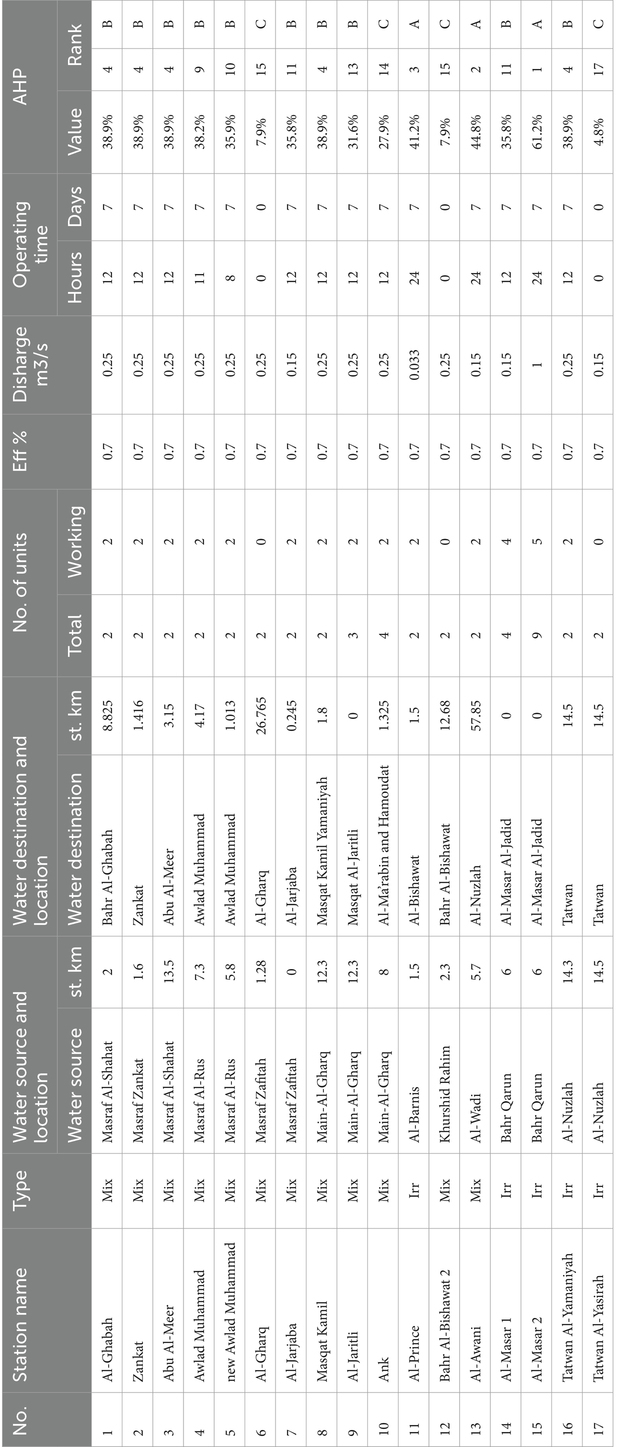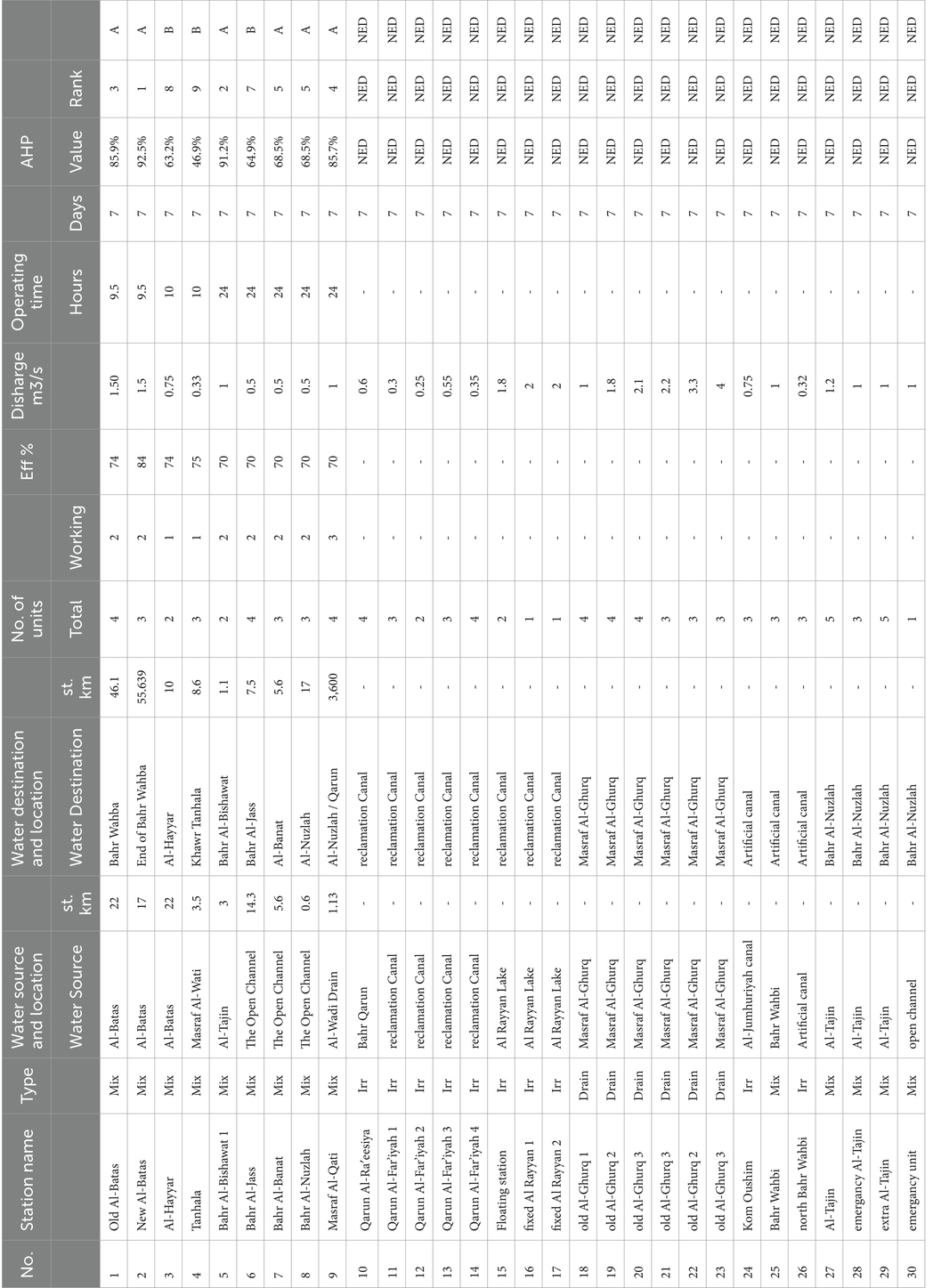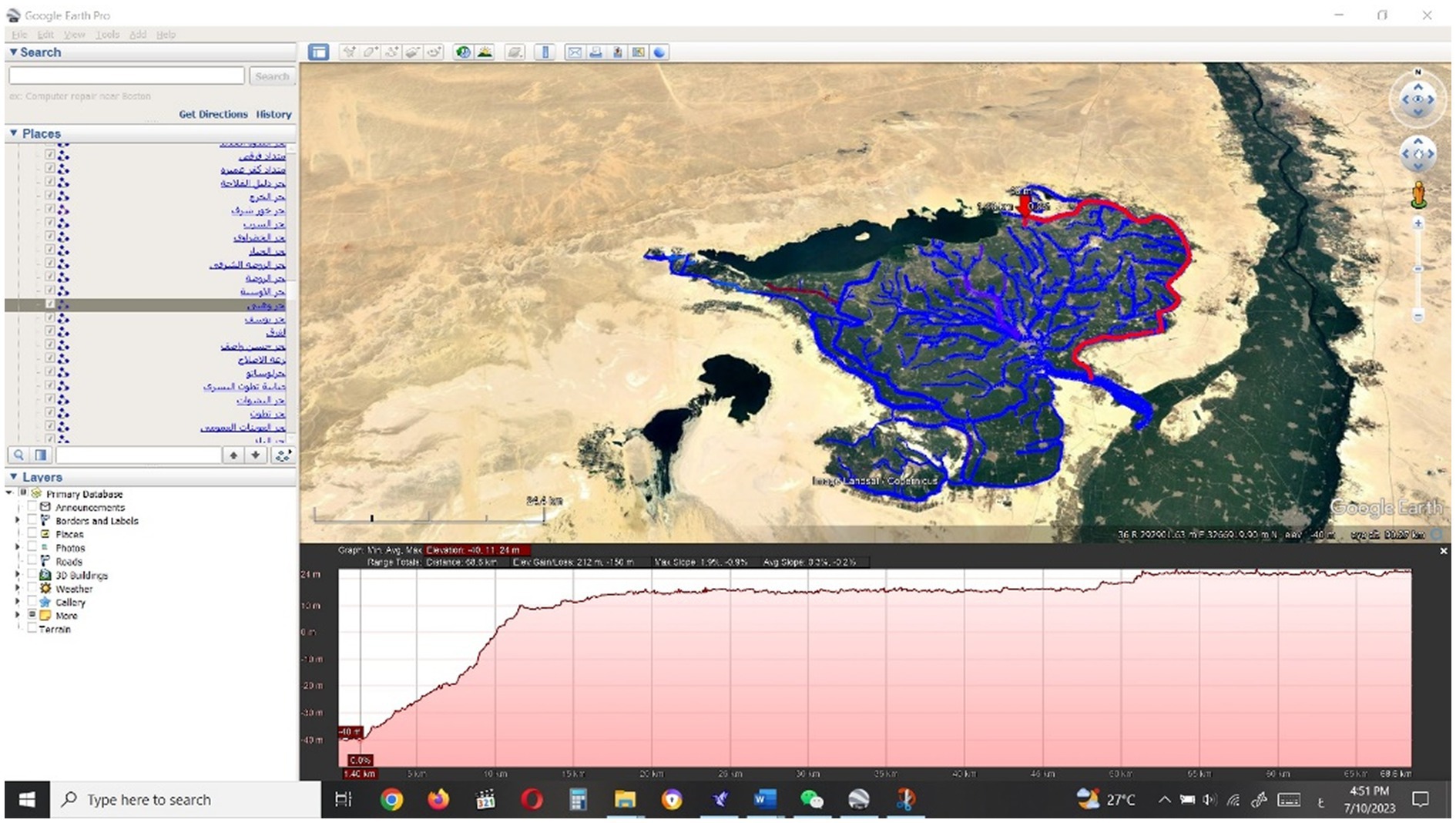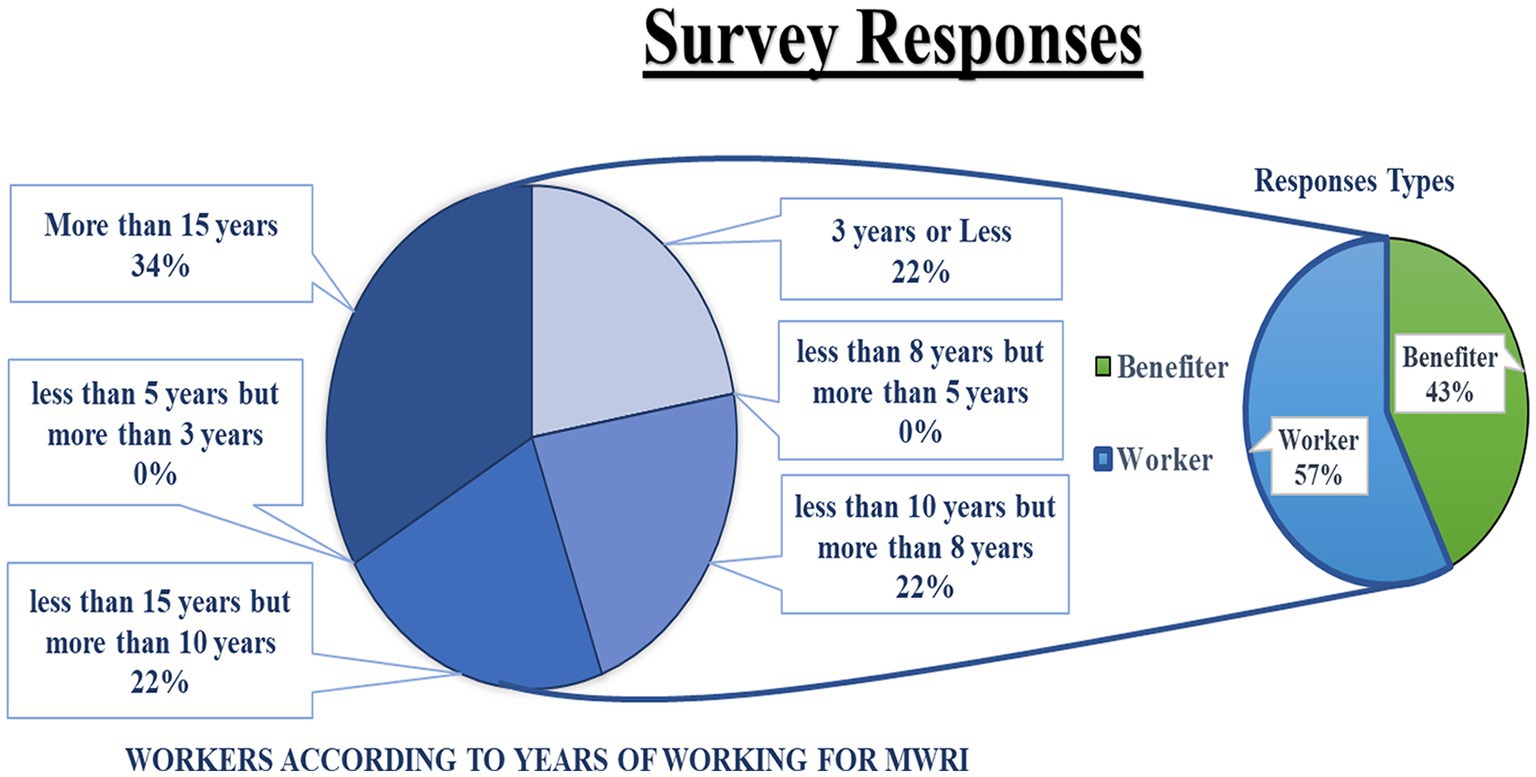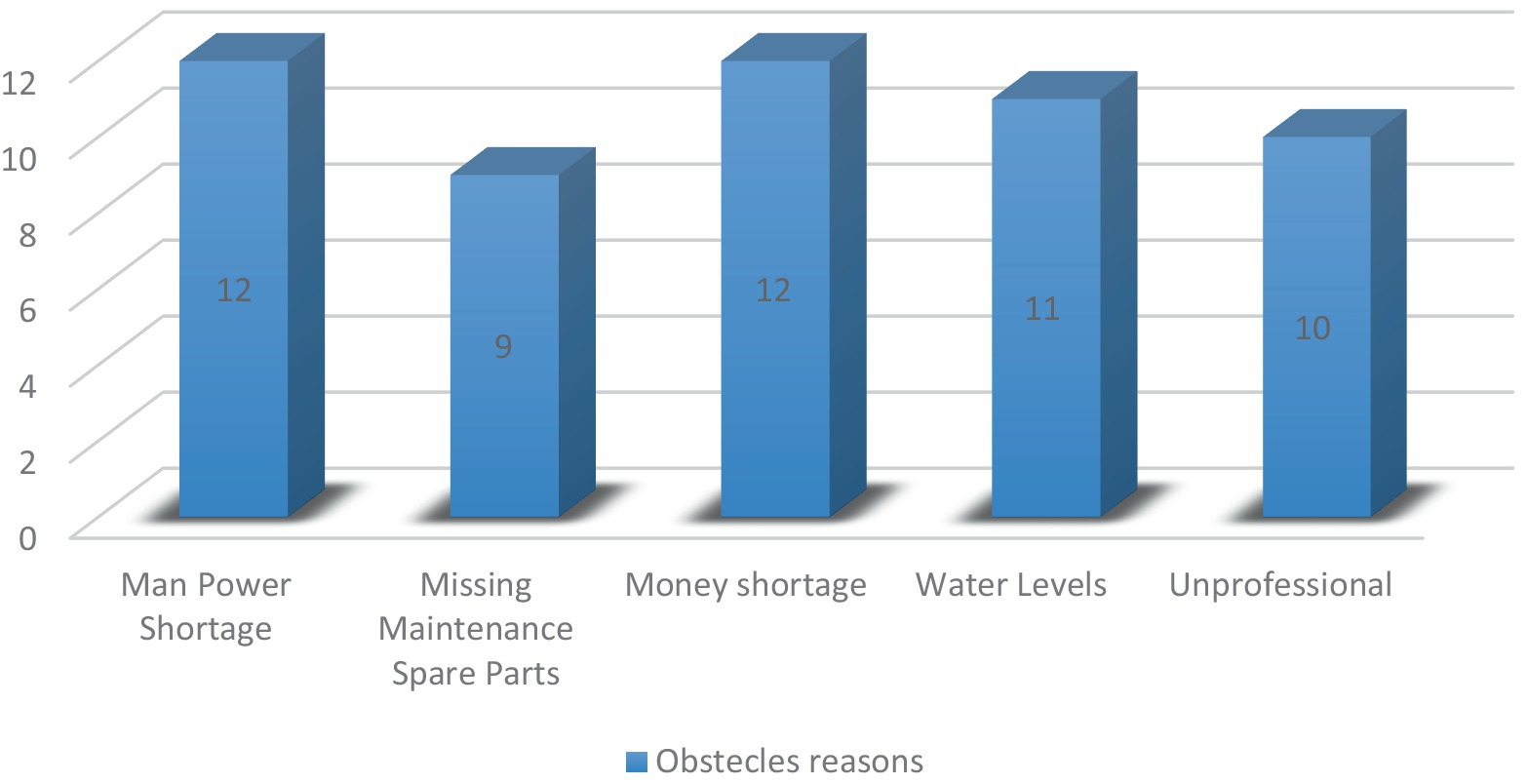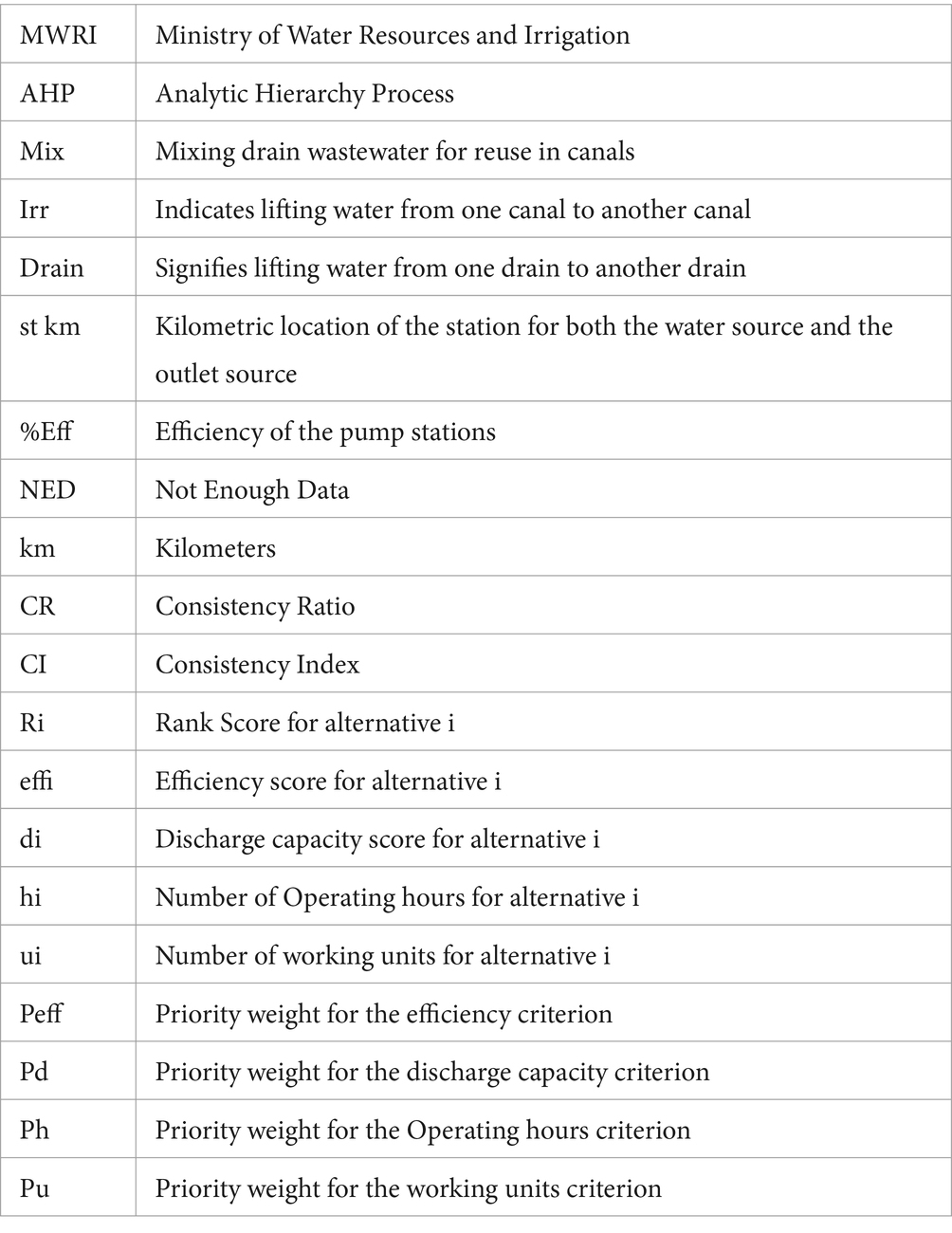- 1College of Hydraulic Science and Engineering, Yangzhou University, Yangzhou, Jiangsu, China
- 2Egyptian Ministry of Water Resources and Irrigation (MWRI), Giza, Egypt
- 3College of Civil Engineering, Tongji University, Shanghai, China
Water scarcity presents significant challenges to sustainable development, particularly in arid regions like Fayoum City, Egypt, which faces particular water challenges due to its unique topography. This study explores the pivotal role of pump stations and wastewater reuse in mitigating water scarcity and promoting sustainable water management practices. Utilizing a comprehensive mixed-method approach, including desk research, field surveys, stakeholder interviews, and integrating the Analytic Hierarchy Process (AHP) into a decision-making framework. The study categorizes pump stations into priority ranking groups based on the evaluation of the following criteria: efficiency, operating hours, working unit ratio, and discharge capacity. The investigation reveals that the 72 pump stations in Fayoum City play a vital role in regulating water levels, optimizing distribution, and facilitating the reuse of irrigation wastewater. Despite operational challenges, such as manpower shortages and maintenance issues, these stations are crucial for sustaining agricultural productivity and addressing water scarcity concerns, including the prevention of recurring inundation events like the one in 2012. Moreover, the study underscores the potential of wastewater reuse as a sustainable solution to water scarcity, particularly in meeting agricultural water demands and mitigating water balance issues, such as inundation. Based on the findings, the study proposes actionable recommendations, including upgrading high-priority pump stations, evaluating lower-priority ones, enhancing canal infrastructure, and promoting water-efficient irrigation methods. In conclusion, this study provides valuable insights into the pivotal role of pump stations and wastewater reuse in addressing water scarcity challenges in arid regions. By implementing the proposed recommendations, Fayoum City can optimize its water management practices, ensure water security, and support the long-term development of the region.
1 Introduction
Water scarcity is a critical global challenge affecting regions across the world, with Egypt being no exception (Damkjaer and Taylor, 2017). One of the most valuable water resources in the region is groundwater, especially in Egypt (Kasem et al., 2024). Fayoum City in particular, faces significant water resource management issues due to limited freshwater resources, increasing water demand, and a delicate water balance. This section provides an overview of the water scarcity, pump stations, wastewater reuse, and water challenges in Fayoum City and outlines the study’s focus on pump stations and irrigation wastewater reuse.
Water scarcity has gained significant attention in recent decades due to its detrimental effects on socio-economic development and livelihoods (Damkjaer and Taylor, 2017; Liu et al., 2017; Ismail et al., 2023). Indicators have been developed to assess various aspects of water scarcity, including population, water availability, and water usage. In the specific case of Egypt, water scarcity is exacerbated by the country’s rapid population growth, resulting in a greater demand for water resources. As a consequence, Egypt has experienced a significant decline in per capita water allocation, decreasing from approximately 2,000 m3/year to around 600 m3/year over the past few decades (Moghazy and Kaluarachchi, 2020). This challenge is further compounded by the presence of limited water resources within the country and the additional strain caused by the upstream consumption of water by neighboring nations (Al Maliki et al., 2020; Luo et al., 2020; Megahed et al., 2023).
Figure 1 depicts the population growth in Egypt since 1955, which has led to concerns regarding the availability of water per capita due to the doubling of the population (Moghazy and Kaluarachchi, 2020). On the other hand, it is important to note that Egypt’s main water resources have remained unchanged since the water agreement “Cooperative Framework Agreement (CFA).” Out of the total water volume of 1,660 BCM/y that is distributed within the Nile basin, Egypt’s allocation is limited to a mere 55.5 BCM/y (El-Rawy et al., 2020; Tawfik et al., 2023), accounting for approximately 97% of the country’s renewable water resources (Hefny and Amer, 2005; Damkjaer and Taylor, 2017; El-Rawy et al., 2020; Salem et al., 2021).
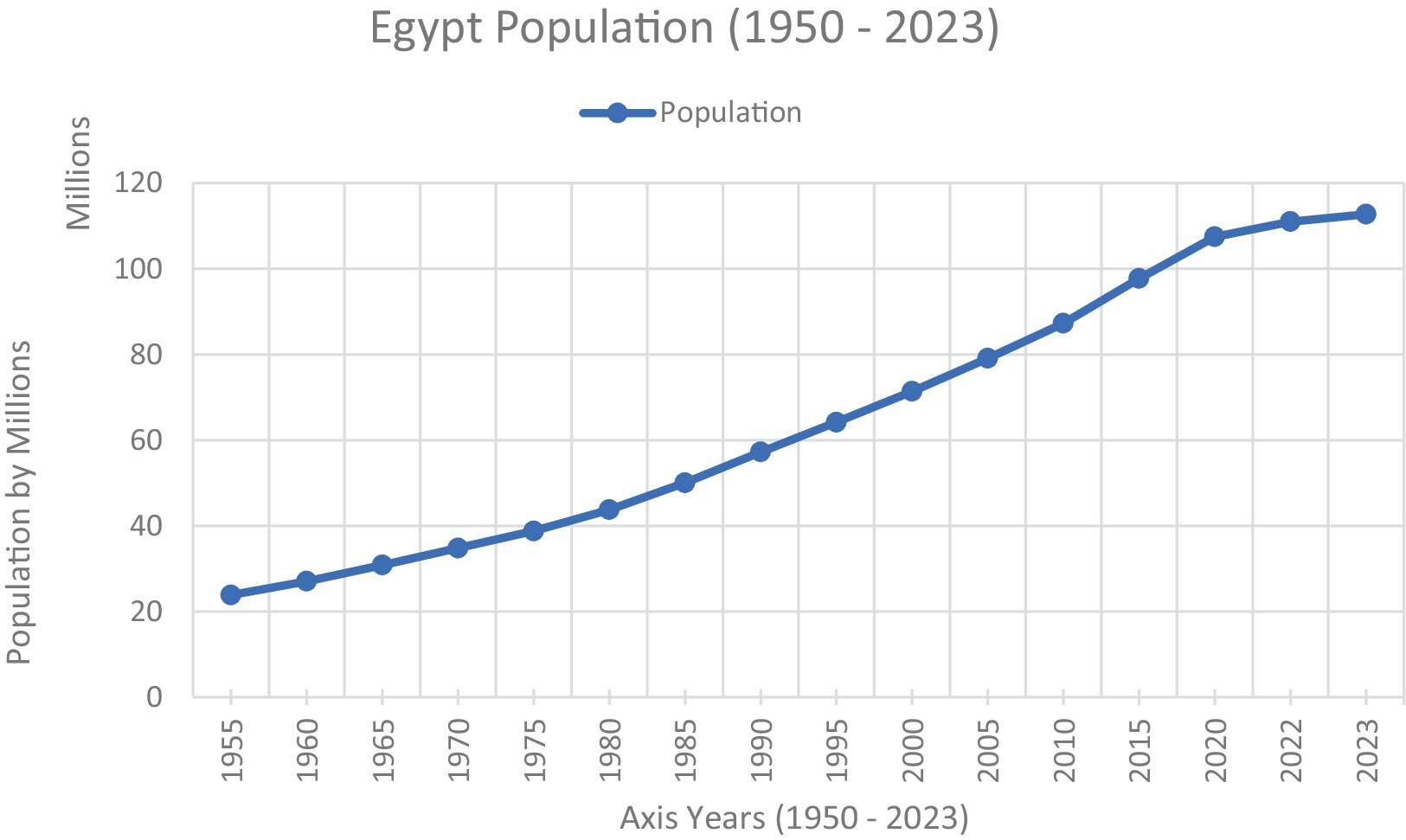
Figure 1. Population of Egypt 2023 (Worldometers.info, 2023).
Egypt has an arid environment with 18 mm of yearly rainfall on average (Moghazy and Kaluarachchi, 2020). Egypt Depends on the Nile for 97% of its water requirements (Elbasiouny and Elbehiry, 2020), while irrigated agriculture accounts for the vast majority (84%) of all the water used (Abu-Zeid, 1992). The sharing of the Nile waters has been a source of conflict between Egypt and other riparian countries (Abdelfattah, 2021), further stressing the water resources situation (Abdelfattah, 2021). In the specific context of Fayoum City, water scarcity and water balance limitations pose significant challenges. The city’s water supply primarily comes from the Nile River and groundwater wells, struggling to meet the growing demands of the population (Wahed et al., 2015). Additionally, the outdated drainage system exacerbates water balance issues, leading to flooding during the rainy season and exacerbates water level fluctuations in Lake Qarun. The delicate balance between water inflow and evaporation in the lake has resulted in inundation events in the past, causing damage to agricultural areas and nearby villages (Omar, 2013; Wahed et al., 2015; Ismail et al., 2023).
Wolters conducted a study on the Fayoum water balance of irrigated lands and Lake Qaroun, highlighting the delicate balance between drainage flow, water levels, and the influence of irrigation practices (Wolters et al., 1989). Fayoum’s irrigation system incorporates features that can be classified as re-use, such as the re-use of drainage water within the system, resulting in a lower Lake Qarun level (Wolters et al., 1989; Barnes, 2014).
Pump stations have emerged as potential solutions in water resources management to address water challenges in Fayoum City. These pump stations play a vital role in enhancing the efficiency of water use, facilitating water reuse, and mitigating water level challenges (Sato et al., 2013). There are continuous efforts being made in Fayoum City to improve the availability of water and enhance the overall effectiveness of irrigation (Abdel Atty, 2018). According to Abdel Atty (2018), the Ministry of Water Resources and Irrigation in Egypt acknowledges the value of recycling wastewater and adopting sustainable water practices. In Egypt, 33% of the water used annually is recycled. However, the successful implementation of wastewater reuse strategies requires careful planning to ensure long-term operation and avoid negative impacts on water quality and the environment.
In the past, Fayoum City experienced an inundation event in 2012 due to a relatively small excess of inflow over evaporation, resulting in a significant rise in the water level of Lake Qarun. This led to the flooding of adjacent land, impacting agricultural areas and nearby villages. The incident highlighted the region’s vulnerability to even minor imbalances in the water system and underscored the importance of effective water resource management (Omar, 2013; Hassan, 2015). Proper management of pump stations’ operation and maintenance is crucial in order to minimize adverse effects on water quality, ecosystem health, and the surrounding environment (El Din and Moussa, 2016).
The purpose of this study is to fill this gap by conducting a detailed investigation into the role of pump stations and wastewater reuse in water resource management in Fayoum City. By employing a mixed-methods approach and utilizing the Analytic Hierarchy Process (AHP), this research aims to gather robust data, evaluate the effectiveness of existing pump stations, and assess the feasibility of wastewater reuse practices. Furthermore, this study seeks to identify challenges hindering the optimal operation of pump stations and propose practical recommendations to enhance their efficiency and sustainability.
The findings of this research have significant practical implications for policymakers, water resource managers, and stakeholders involved in water management in Fayoum City and similar water-stressed regions worldwide. By providing insights into the potential of pump stations and wastewater reuse, this study offers valuable guidance for developing strategies to mitigate water scarcity, optimize water distribution, and promote sustainable development. Ultimately, the outcomes of this research can inform evidence-based decision-making and contribute to the implementation of effective water management practices that address the unique challenges of water scarcity in Fayoum City and beyond.
2 Materials and methods
2.1 Study area
The study focuses on Fayoum City, which has different names online like (Fayoum Governorate, Fayoum Depression, Fayoum Oasis or Fayoum City) is an ideal case study for this research due to its unique location and water Challenges. Figure 2 shows a map of Egypt and the Location of Fayoum City located in the Western Desert of Egypt. Fayoum City covers an area of 6,068 km2 and is situated approximately 95 kilometers southwest of Cairo, the capital of Egypt. The region has a unique topographical regarding huge differences in land Elevation and Limited Water Resources and Limited outlet Water Capacity and geographical setting with the Nile River flowing through it, providing a vital water source for irrigation and other uses.
Figure 3 showcases the journey of Fayoum’s freshwater share from the Aswan High Dam through the Nile River and various barrages, culminating in the Ibrahimya Canal at Asyut Barrage (Abdrabbo, 2009; Omar, 2013). Additionally, it visualizes the geographical distance of Fayoum City from the primary inflow and outflow streams.
Fayoum Governorate is known for its rich agricultural lands, making it one of the main agricultural hubs in Egypt. Fayoum Governorate had a population of 2.48 million (January 2005 census) and recently recorded 3.849 million (2020). Fayoum City, which is the principal municipality, occupies a natural closed depression in the Western Desert of Egypt between 29°020 and 29°350 N and 30°230 and 31°050E. The region’s economy heavily relies on agriculture, and the majority of its population is engaged in farming activities. However, the rapid growth in population and agricultural expansion has put significant pressure on the available water resources, leading to water scarcity and water balance challenges. It should be taken into account that Fayoum’s water outlets are limited to Qaroun Lake and Wadi El Rayan Lake, which are both of Limited Capacity as shown on Figure 2 which displays Fayoum city, Qarun Lake and Wadi El Ryan.
2.2 Data and methodology
The study employs a mixed-methods approach to gather data and evaluate the potential of pump stations and wastewater reuse in Fayoum City. The methodology encompasses the following key steps:
2.2.1 Desk Research
The study begins with an extensive desk research phase, where existing literature on water resource management, pump stations, and wastewater reuse in Egypt and other relevant countries is reviewed. This literature review helps establish the background and context for the research, identify gaps in knowledge, and understand the current state of water challenges in Fayoum City. It also provides valuable insights into pump station assessments and their effectiveness in other water-scarce regions.
2.2.2 Field Surveys
Conducted during my tenure with the Ministry of Water Resources and Irrigation (MWRI) in Fayoum, these surveys helped in gathering pertinent data on pump station usage, water resources, and drainage storage in the region. Physical visits were made to pump stations, water sources, and agricultural areas. The collected data included pump station capacities, discharge volumes, water levels, and the condition of irrigation infrastructure. The surveys also documented information about the existing water resources and the drainage systems in Fayoum City, offering a comprehensive understanding of the current water management scenario.
2.2.3 Interviews with Stakeholders
Interviews were conducted orally and through a questionnaire with 47 participants with various stakeholders involved in water resource management in Fayoum City. This includes government officials, engineers, farmers, and representatives from the Ministry of Water Resources and Irrigation (MWRI). Notably, both the East and West Administrations of Irrigation in Fayoum are each operated by around 20 engineers. The interviews provided valuable insights into the challenges and opportunities of pump station usage, water recycling, and wastewater reuse in agricultural practices. Stakeholders’ perspectives help in understanding the practical implications of pump station operations and identify areas for improvement.
Figure 4 represents the survey design, demonstrating the sections of questions targeting specific individuals. This approach aimed to prevent scattered or unfocused responses.
2.2.4 Analytic Hierarchy Process (AHP)
The Analytic Hierarchy Process (AHP) was employed to conduct a thorough evaluation of pump stations according to specific criteria. Engineers with practical experience in pump station operations or maintenance participated in a survey determine the relative importance of these criteria. Through pairwise comparisons, priority weights were calculated for each criterion using the AHP methodology. These weights were then aggregated to objectively rank pump stations, laying a systematic foundation for decision-making and resource allocation. A widely acknowledged decision-making tool, AHP facilitates the establishment of a priority list for alternatives via pairwise comparisons, leveraging a numerical scale devised by Saaty to streamline the comparison process (Saaty, 1980; Vargas, 1990; Saaty, 2001; González-Pavón et al., 2024).
2.2.4.1 Hierarchical structure
A hierarchical structure was employed to guide the assessment process, as depicted in Figure 5. At the top level, the decision goal was defined, with lower levels representing elements influencing the decision and specific evaluation criteria. These criteria encompassed efficiency, operating hours, and working units ratio. The construction of this structure was recommended based on the data collected, ensuring a comprehensive evaluation process (Saaty, 1980).
2.2.4.2 Criteria evaluation
The assessment of pump stations relied on predetermined criteria, including efficiency, operating hours, working units’ ratio, and discharge capacity. To engage engineers with relevant experience, 20 qualified respondents out of 27 participated in a survey to gauge the importance of each criterion using Saaty’s numerical scale, ranging from 1 (equally important) to 9 (extremely important). Their assessments facilitated the creation of pairwise comparison matrices. The derived weights were then calculated using equations (1, 2), showcasing the criteria’s relative significance. These findings are summarized in Table 1 for reference (Saaty, 1980; AlAli et al., 2023; Nguyen et al., 2023).
The AHP method involves several steps: constructing the pairwise comparison matrix, normalizing the matrix, calculating the priority weights for the criteria/alternatives, checking consistency, and aggregating rank scores. These steps ensure a systematic evaluation process.
2.2.4.3 Here are the general equations for each step of the AHP method
It is worth noting that all equations referenced in this study, including those used for calculating priority weights and ranking pump stations, are grounded in Saaty’s (1980) Analytic Hierarchy Process or draw inspiration from his pioneering work in decision-making methodologies. This ensures the reliability and validity of our analytical framework and enhances the robustness of our findings.
Step 1: Pairwise Comparison Matrix Construction
To construct the pairwise comparison matrix for comparing criteria or alternatives, let us assumed that we have n criteria/alternatives. The pairwise comparison matrix denoted as C will have elements cij, where i and j represent the row and column indices, respectively. The elements of the matrix are given by:
where wi and wj are the weights assigned to criteria/alternatives i and j, respectively.
Step 2: Normalization of Pairwise Comparison Matrix
To normalize the pairwise comparison matrix, we divide each element of the matrix by the sum of its respective column. The normalized matrix N is obtained as follows:
where nij represents the normalized value of element cij, and Σ(ckj) represents the sum of the column j.
Step 3: Calculation of Criteria/Alternative Priority Weights
To calculate the priority weights for criteria/alternatives, we take the average of the elements in each row of the normalized matrix. The priority weight vector P is calculated as follows:
where pi is the priority weight assigned to criteria/alternative i, given by:
where n and nik represents the normalized value of element cik, and Σ(nik) represents the sum of the rowi.
Step 4: Consistency Check
To ensure the consistency of the pairwise comparisons, we calculate the consistency ratio (CR). The consistency index (CI) is calculated using the formula:
where λ_max is the maximum eigenvalue of the pairwise comparison matrix, and n is the order of the matrix.
The consistency ratio (CR) is then calculated as follows:
where RI represents the random index obtained from a reference table based on the matrix size.
Step 5: Aggregation of Criteria/Alternative Rank Scores
To obtain an overall rank score for each alternative, we’ll calculate the weighted sum of the individual criteria scores. The rank score R for each alternative i is given by:
where Ri represents the rank score for alternative i, eff i represents the efficiency where Ri represents the rank score for alternative i, effi represents the efficiency score for alternative i, di represents the discharge capacity score for alternative i, hi represents the number of Operating hours for alternative i, Peff represents the priority weight for the efficiency criterion, Pd represents the priority weight for the discharge capacity criterion, Ph represents the priority weight for the Operating hours criterion, Pu represents the priority weight for the working units criterion, and tui represents the total number of units for alternative i.
To analyze the data, calculate the criteria weights, and determine the ranks of pump stations, Microsoft Excel software was utilized. Equations ranging from 1 to 9 were used to input the values obtained from the survey responses. This methodology enabled the determination of criteria weights for each criterion and subsequent prioritization of pump stations.
3 Results and discussion
3.1 Data and analysis
Based on the proposed methodology, the Fayoum Irrigation system is delivered through a multi-branch network of canals, comprising approximately 350 canals (shown on map Figure 6). Most of these canals were naturally formed by the unique topography of the land (topography map for Egypt at Figure 7 and topography map for Fayoum at Figure 8). The infrastructure of the system is about 100 years old. Therefore, it faces various challenges, including wasteful irrigation techniques employed by farmers, such as excessive watering (Abdel Atty, 2018).
To sustain the water needs and balance in Fayoum, irrigation wastewater is reused both officially and non-officially, not only by the farmers themselves at the poor water regions by the tail end of canals due to excessive watering by upstream farmers but also officially reused by the Ministry of Water Resources and Irrigation (Wolters et al., 1989; Barnes, 2014). Currently, there are 72 pump stations in operation in Fayoum, detailed in Tables 2–4. These pump stations are categorized based on their functions: draining to drain (6 stations), canal to canal (17 stations), and drain to canal (49 stations). Most stations have small discharge capacities, around 0.2 m3/s.
It is important to note that not all pump stations are operated by the same authority. Different administrations and departments, such as the Electro Mechanical Department at MWRI, the General Administration of Eastern Fayoum Irrigation, and the General Administration of Western Fayoum Irrigation. These entities oversee and manage these pump stations. The Electro Mechanical Department generally possesses more specialized expertise in dealing with pump stations mechanically.
However, some of the pump stations operated by the Irrigation Department face issues and do not fully operate as designed. These issues include water level shortages, difficulties with water withdrawal at the pump station inlet, and the potential for inlet pipe obstructions. It is advisable to consider these obstacles when designing future pump stations, taking into account the actual working environment, as certain areas are prone to recurring pipe clogging (El-Agha et al., 2011).
The majority of pump stations constructed and managed by the Irrigation Department were built as quick and reasonable solutions to address water shortages in the tail ends of canals, primarily for irrigation purposes. However, this repeated pattern lacked a detailed strategic study and has gradually led to a domino effect. For instance, many pump stations were established to address issues in branched canals based on the same drainage resource. This has caused the water level in the drain to fall below the required level for some pump stations to function properly, resulting in the need for decision makers to shut down or reduce the working hours of certain pump stations to avoid further consequences (Reggiani et al., 2022).
The reuse of wastewater in irrigation is a common practice in Fayoum, with ongoing efforts by MWRI are made to monitor the water mixing process to maintain compliance with irrigation standards (Khairy et al., 2022). However, significant challenges exist regarding the discharge of untreated urban, municipal, and industrial wastewater into agricultural drains. This raw sewage flows into the drains, creating constraints for the reuse of irrigation drainage water. Heavy pollution has even led to the shutdown of certain pump stations in the Delta region. The use of drainage water without proper treatment may have long-term effects on the sustainability of the land, increasing its salinity due to the deterioration of water quality (El-Agha et al., 2011).
Figure 9 illustrates the striking elevation change along the Bahr Wahba Canal, one of the main distribution canals in Fayoum. Over a relatively short distance of less than 55 kilometers, the canal experiences a rapid transition in elevation. Starting at an altitude of 24 meters above sea level, it descends dramatically to a depth of −40 meters. This significant drop showcases the impressive and rapid changes in elevation within the canal’s course.
Figure 6 provides a visual representation of the intricate network of canals crisscrossing the landscape. It also illustrates how numerous pump stations are closely clustered within a kilometer radius. This depiction not only highlights the extensive reach of the canal system but also emphasizes the high density of water infrastructure in the region. By visually depicting the spatial distribution of pump stations in relation to the canal network, the figure offers valuable insights into the interconnectedness and complexity of the water management infrastructure in the study area.
Figure 7 offers a comprehensive topographic overview, highlighting the significance of comprehending elevation differences in the context of efficient water management. The map presents a visual representation of Egypt’s topography, utilizing color gradients to indicate variations in elevation. Several key points were measured and included on the map, such as the Mediterranean Sea, which serves as the reference point with an elevation of 0.0 meters. Additionally, specific locations within Egypt were measured, including the Fayoum Water Inlet area, which exhibited an elevation of +23 meters, and Lake Qarun, which displayed an elevation of −47 meters. These measurements provide valuable insights into the elevation disparities across different regions and emphasize the importance of understanding these variations for effective water management strategies.
Figure 8 provides an in-depth exploration of the intricate topography of Fayoum, specifically highlighting the variations in elevation from the water inlet to the outlet, which encompasses Lake Qarun and Wadi El Rayan. This detailed map offers a closer view of Fayoum’s topography, using color gradients to represent the differences in elevation. To illustrate the significant elevation and the drop from the water inlet at approximately +25 meters, measurements were taken at various points within Fayoum, including Lake Qarun and Wadi El Rayan. These measurements reveal that the water outlet at Lake Qarun is situated at an elevation of −47 meters, while Wadi El Rayan ranges from −14 meters to −36 meters. This comprehensive analysis allows for a better understanding of the substantial elevation changes experienced from the water inlet to the water outlet in Fayoum, as well as the specific elevation levels of Lake Qarun and Wadi El Rayan.
After aggregating the priority weights, an overall measure of importance was obtained for each pump station, according to the collected data from the field survey and application of the AHP methodology output into equation (9). This facilitated the ranking of the stations based on their assessed importance, providing an objective foundation for comparison and decision-making. Consequently, the pump stations were categorized into three groups: Group A, representing the top 20% in terms of priority; Group B, representing intermediate priority; and Group C, representing the lowest 20% in terms of priority. These distinct rankings serve as valuable tools for effective decision-making and resource allocation in pump station management. The rankings for each department are presented in Tables 2–4, along with the accompanying data and results.
• Type: “Mix” denotes mixing drain wastewater for reuse in canals, “Irr” indicates lifting water from one canal to another canal, and “Drain” signifies lifting water from one drain to another drain.
• Water Source or Destination (“st km”): Kilometric location of the station for both the water source and the outlet source.
• (%Eff): Efficiency of the pump stations, as reported by the Ministry of Water Resources and Irrigation.
• AHP: Represents the Priority Rank Percentage, ranking stations into Group A, B, or C based on the chosen criteria.
• Note: The symbol (-) in the table indicates that the data could not be acquired during the research time, resulting in “NED” representing Not Enough Data to evaluate.
3.2 Pump stations managed by various departments
Tables 2–4 provide detailed insights into the pump stations managed by different departments within the Ministry of Water Resources and Irrigation (MWRI) in Fayoum City.
Tables 2, 3 outline the pump stations managed by the East Fayoum Irrigation Department and West Fayoum Irrigation Department, respectively. These tables illustrate the diverse usage patterns of the pump stations, primarily focused on lifting water from one canal to another canal (“Irr”) or mixing irrigation wastewater from drains to canals (“Mix”). Essential information such as station names, kilometric locations for both the water source and the outlet source (“st km”), and the reported efficiency of the pump stations (%Eff) by the MWRI are included. As for Table 4, the focus shifts to pump stations managed by the Department of Mechanics and Electricity. These stations serve distinct purposes such as lifting water from canal to canal, mixing irrigation wastewater from drains to canals, or lifting water from drain to drain. The table compiles essential data, including the station name, water sources with kilometric locations for both the water source and outlet source, the number of units, and their efficiency (%Eff) based on measurements and formal reports from the MWRI.
3.3 Pump stations distribution
Tables 2–4 provide a comprehensive overview of the distribution and categorization of pump stations managed by various departments within the Ministry of Water Resources and Irrigation (MWRI) in Fayoum City. These tables outline the diverse functions of pump stations, including lifting water from one canal to another canal (“Irr”), mixing irrigation wastewater from drains to canals (“Mix”), or lifting water from one drain to another drain. Additionally, based on the data from the tables, it is observed that there are a total of 72 pump stations administered by the Mechanical Department and the Irrigation Department at the MWRI in Fayoum City, which are distributed as follows:
• Pump stations for Mixing from Drainage: 49
• Pump Stations supply from canals: 17
• Pump stations for Drainage Purpose: 6
The tables include essential information such as station names, kilometric locations for both the water source and the outlet source, the number of units, and their reported efficiency by the MWRI. Additionally, the pump stations were categorized into three groups: Group A, which represents the top 20% in terms of priority; Group B, indicating intermediate priority; and Group C, represents the lowest 20% in terms of priority and significance of each station.
3.4 Role of pump stations in overcoming water scarcity
Fayoum City, which is confronted with severe water scarcity and water balance limitations, relies on pump stations as vital tools in sustainable water resources management. Pump stations play a crucial role in enhancing water efficiency, facilitating water reuse, and mitigating water level challenges (Sato et al., 2013). By strategically distributing water resources, pump stations optimize water supply to meet the irrigation needs of farmers throughout the region. The re-use of drainage water within the irrigation system has proven to be an effective approach, resulting in a reduction in the water level of Lake Qarun level and addressing water balance issues (Wolters et al., 1989).
3.5 Inundation event in 2012 and pump station adaptations
An significant adverse incident occurred in 2012 when Fayoum City experienced an inundation event due to a relatively small excess of inflow over evaporation (Omar, 2013; Hassan, 2015). This incident highlighted the vulnerability of the region to even minor imbalances in the water system. As a response, efforts were made to adapt pump station operations to mitigate future inundation risks. Improved pump station management played a crucial role in preventing a recurrence of such events by efficiently regulating the flow of water and preventing excessive water accumulation.
3.6 Challenges and opportunities of wastewater reuse through pump stations
Wastewater reuse presents a potential solution to address water scarcity challenges in Fayoum City. The Ministry of Water Resources and Irrigation recognizes the importance of sustainable water practices and the significance of recycling wastewater (Abdel Atty, 2018). Pump stations play a pivotal role in the transportation of irrigation wastewater, ensuring its successful integration into water resource planning. However, the successful implementation of wastewater reuse strategies requires careful planning to ensure long-term operation and to avoid adverse impacts on water quality and the environment (Khairy et al., 2022).
3.7 Pump station efficiency and future recommendations
The efficiency of pump stations is a critical factor in sustainable water resources management. Proper maintenance, regular monitoring, and innovative technologies can improve pump station performance and reduce water losses. Implementing smart control systems and real-time monitoring can optimize pump station operations, ensuring a more equitable distribution of water resources and mitigating the impacts of water scarcity.
3.8 The questionnaire
The Questionnaire outlined in Figure 4 Survey Design Diagram, targeted specific groups with tailored questions. This approach ensured focused responses and enhanced the quality of our data. A total of 47 surveys were collected, with 27 of them completed by governmental engineers who hold key responsibilities in water resource management and 20 by beneficiaries.
Figure 10 illustrates the distribution of the survey participants. Out of the 47 survey respondents, 27 were formal engineers responsible for water resource management. The figure provides insights into the differences and gaps in their work experience over time. It is notable that there was a period of approximately 5 years without any new members joining the workforce. This observation highlights the potential challenges in knowledge transfer and sharing among the engineers, which may contribute to discrepancies in their perspectives on water resource management.
Figure 11 presents the responses from 20 participants who had direct interactions with pump stations in their previous work. These participants were asked to identify the obstacles hindering the enhancement of pump stations’ role in managing water resources in Fayoum. The following reasons were chosen by the participants: manpower shortage, lack of maintenance spare parts, financial constraints, unprofessional contractors, and water level issues. These reasons reflect the challenges faced in optimizing pump station operations and highlight the areas that need attention to improve their effectiveness in water resource management. By addressing these obstacles, such as ensuring an adequate workforce, securing necessary spare parts, allocating sufficient financial resources, hiring professional contractors, and addressing water level fluctuations, the overall efficiency and functionality of pump stations can be improved.
3.8.1 Insights from the questionnaire and subsequent discussions reveal the following key points
3.8.1.1 Engineer backgrounds
The survey results indicate that approximately 78% of the working engineers surveyed have more than 8 years of experience. However, their knowledge backgrounds and perspectives on water resource usage and pump stations varied significantly. This discrepancy can be attributed to the diverse nature of their job descriptions, which leads to distinct views on water distribution responsibilities. The irregular pattern of hiring new workers also contributes to a gap in transferring and sharing work experience.
3.8.1.2 Optimization opportunities
Engineers with hands-on experience in pump station operations, particularly those involved in site operations, generally agree that there are opportunities for optimization. They emphasized that not all pump stations hold the same importance or are equally efficient. There is a consensus among the participants that shutting down at least one pump station would not have a significant impact, while upgrading at least one station could greatly alleviate water scarcity in Fayoum.
3.8.1.3 Maintenance challenges
Pump station maintenance faces several challenges affecting work effectiveness. These challenges include manpower shortage, lack of maintenance spare parts, financial constraints, unprofessional contractors, and water level issues. Addressing these challenges requires a comprehensive approach, such as securing better financial support to hire professional contractors and ensuring an adequate supply of maintenance spare parts.
3.8.1.4 Beneficiary perspectives
Beneficiaries in Fayoum hold diverse views on water scarcity and the usage of pump stations, which are largely influenced by the location of their land. Some beneficiaries consider pump stations crucial for their survival and take matters into their own hands for maintenance. Others see pump stations as a means to increase water availability, while some are unaware of their role. Additionally, the majority of beneficiaries still use traditional irrigation methods, such as irrigation by immersion. Around 55% of the respondents marked water availability as more important than water quality, while only about 10% expressed a greater interest in water quality.
3.8.1.5 Beneficiary influence
Beneficiaries in Fayoum have historically influenced policy decisions, often resulting in short-term gains. This interference has hindered free strategic planning, with complaints and adherence to outdated irrigation methods despite changing circumstances. Political and security aspects further complicate the decision-making process.
These insights underscore the complexity of managing water resources in Fayoum, emphasizing the need for a holistic approach that considers diverse perspectives and addresses challenges in both pump station operations and beneficiary involvement.
4 Conclusion
In conclusion, pump stations have been vital in addressing Fayoum City’s unique topography and rising water demands amidst a fixed share of Nile River resources. They’ve effectively managed water levels, preventing inundation events like the one in 2012, and minimized water scarcity at canal ends. Despite wastewater treatment challenges, pump stations have maintained a delicate water balance, meeting agricultural needs and reducing water scarcity complaints. Their strategic role in optimizing distribution and facilitating wastewater reuse underscores their importance in sustainable water management, supporting agricultural development and alleviating water scarcity challenges in the region.
4.1 To ensure sustainable water resource management and address The increasing water demands in Fayoum City, the following recommendations are suggested
1. Enhance A-ranked pump stations’ efficiency by investing in upgrades and maintenance, ensuring regular upkeep and optimizing infrastructure for improved water transfer.
2. Improve B-ranked pump stations’ performance by focusing resources on enhancing operations within the canal network, ensuring efficient water distribution.
3. Evaluate the necessity of operating C-ranked pump stations, considering alternatives like redirecting water flows if operation is deemed economically unviable.
4. Upgrade canal infrastructure, including pipelines and valves, to minimize water losses and maximize delivery efficiency.
5. Promote efficient irrigation methods among farmers, encouraging the adoption of modern techniques like drip irrigation to minimize wastage and maximize efficiency.
By implementing these measures, along with ongoing assessment and adaptation of pump station priorities, will support sustainable water management in Fayoum City, addressing evolving needs and ensuring effective resource allocation.
The justification for our work lies in its practical implications for sustainable water resource management. By emphasizing the importance of pump stations and wastewater reuse, our findings offer actionable insights for policymakers, water resource managers, and stakeholders involved in addressing water scarcity challenges worldwide. Despite the challenges associated with wastewater treatment, the careful reuse of irrigation wastewater has proven to be an effective strategy for maintaining a delicate water balance and meeting agricultural water demands.
4.2 Insights and recommendations for future work
In addition to the insights gained from our study, several avenues for future research emerge that could enhance our understanding of water resource management in Fayoum City and beyond. Firstly, further investigation is needed to explore the long-term impacts of pump station operations and wastewater reuse on water quality, soil health, and agricultural productivity. Future studies could employ longitudinal approaches and advanced modeling techniques to assess the sustainability of these practices over time. Additionally, there is a need for interdisciplinary research that integrates social, economic, and environmental perspectives to develop holistic water management strategies. Furthermore, exploring innovative technologies and practices, such as smart irrigation systems and decentralized wastewater treatment solutions, could offer promising avenues for enhancing water efficiency and resilience in water-scarce regions. By addressing these research gaps and embracing interdisciplinary collaboration, future studies can contribute to more effective and sustainable water management practices, benefiting communities facing water scarcity challenges worldwide.
In summary, our study contributes valuable insights into the potential of pump stations in addressing water challenges and promoting sustainable water resource management, especially in unique topographic regions with delicate water balance, such as Fayoum City. By offering practical recommendations and future research directions, we aim to support ongoing efforts to enhance water security, foster sustainable development, and promote resilience in water-stressed regions like Fayoum City.
Data availability statement
The original contributions presented in the study are included in the article/Supplementary material, further inquiries can be directed to the corresponding author.
Ethics statement
Ethical review and approval was not required for the study on human participants in accordance with the local legislation and institutional requirements. Written informed consent from the (patients/participants OR patients/participants legal guardian/next of kin) was not required to participate in this study in accordance with the national legislation and the institutional requirements.
Author contributions
SK: Conceptualization, Data curation, Investigation, Methodology, Validation, Visualization, Writing – original draft, Writing – review & editing. LC: Data curation, Funding acquisition, Methodology, Project administration, Resources, Supervision, Validation, Visualization, Writing – review & editing. MA: Writing – original draft. ME: Writing – original draft. AN: Writing – original draft.
Funding
The author(s) declare that no financial support was received for the research, authorship, and/or publication of this article.
Acknowledgments
I would like to express my sincere gratitude to LC, my supervisor and the Dean of the Faculty of Hydraulic Engineering at Yangzhou University, for his invaluable guidance, support, and expertise throughout this research. I am deeply thankful to the Chinese Government Scholarship (CSC) for providing financial support, enabling me to pursue my academic aspirations and undertake this study. I extend my thanks to my colleagues at the Egyptian Ministry of Water Resources and Irrigation, as well as fellow researchers, for their valuable insights, collaboration, and support during the research process. Their contributions have greatly enriched the findings and conclusions of this study. I would also like to express my appreciation to the participants who generously shared their time and knowledge for this study, as their contributions have been instrumental in shaping the findings and conclusions. Lastly, I want to acknowledge and thank my family for their unwavering love, understanding, and encouragement. Their support has been a constant source of motivation. In summary, I am sincerely grateful to everyone who has played a part in making this research possible, particularly LC, for his mentorship, expertise, and support throughout the entire process.
Conflict of interest
The authors declare that the research was conducted in the absence of any commercial or financial relationships that could be construed as a potential conflict of interest.
Publisher’s note
All claims expressed in this article are solely those of the authors and do not necessarily represent those of their affiliated organizations, or those of the publisher, the editors and the reviewers. Any product that may be evaluated in this article, or claim that may be made by its manufacturer, is not guaranteed or endorsed by the publisher.
Supplementary material
The Supplementary material for this article can be found online at: https://www.frontiersin.org/articles/10.3389/frwa.2024.1386303/full#supplementary-material
References
Abdel Atty, M. (2018). "Egypt's strategy for managing water resources." Available at: https://www.amcham.org.eg/cyberlink/events/view/1133/egypts-strategy-for-managing-water-resources (Accessed 02 April 2018).
Abdelfattah, M. A. (2021). Climate change impact on water resources and food security in Egypt and possible adaptive measures. Emerging challenges to food production and security in Asia, Middle East, and Africa: Climate risks and resource scarcity. M. Behnassi, M. B. Baig, M. HaibaEl, and M. R. Reed. Cham, Springer International Publishing: 267–291.
Abdrabbo, A. (2009). "Crop water productivity as influenced by irrigation improvement in the Nile Delta" In: Proceedings of the 2009 Reno, Reno, Nevada: 21–24.
Abu-Zeid, M. (1992). Water resources assessment for Egypt. Can J Dev Stud 13, 173–194. doi: 10.1080/02255189.1992.9669489
Al Maliki, A. A., Abbass, Z. D., Hussain, H. M., and Al-Ansari, N. (2020). Assessment of the groundwater suitability for irrigation near Al Kufa City and preparing the final water quality maps using spatial distribution tools. Environ. Earth Sci. 79:330. doi: 10.1007/s12665-020-09060-w
AlAli, A. M., Salih, A., and Hassaballa, A. (2023). Geospatial-based analytical hierarchy process (AHP) and weighted product model (WPM) techniques for mapping and assessing flood susceptibility in the Wadi Hanifah Drainage Basin, Riyadh region, Saudi Arabia. Water 15:1943. doi: 10.3390/w15101943
Barnes, J. (2014). Mixing waters: the reuse of agricultural drainage water in Egypt. Geoforum 57, 181–191. doi: 10.1016/j.geoforum.2012.11.019
Damkjaer, S., and Taylor, R. (2017). The measurement of water scarcity: defining a meaningful indicator. Ambio 46, 513–531. doi: 10.1007/s13280-017-0912-z
El-Agha, D. E., Molden, D. J., and Ghanem, A. M. (2011). Performance assessment of irrigation water management in old lands of the Nile delta of Egypt. Irrig. Drain. Syst. 25, 215–236. doi: 10.1007/s10795-011-9116-z
Elbasiouny, H., and Elbehiry, F. (2020). “Rice production in Egypt: the challenges of climate change and water deficiency” in Climate change impacts on agriculture and food security in Egypt: Land and water resources—Smart farming—Livestock, fishery, and aquaculture. eds. E.-S. E. Omran and A. M. Negm (Cham: Springer International Publishing), 295–319.
El Din, M. O., and Moussa, A. M. (2016). Assessment of groundwater resources in Siwa Oasis, Western Desert, Egypt. J. Adv. Res. 7, 403–412.
El-Rawy, M., Abdalla, F., and El Alfy, M. (2020). “Water resources in Egypt” in The geology of Egypt. eds. Z. Hamimi, A. El-Barkooky, J. M. Frías, H. Fritz, and Y. A. El-Rahman (Cham: Springer International Publishing), 687–711.
González-Pavón, C., Palau, C. V., Juárez, J. M., Estruch-Guitart, V., Guillem-Picó, S., and Balbastre-Peralta, I. (2024). Optimization of collective irrigation network layout through the application of the analytic hierarchy process (AHP) multicriteria analysis method. Water 16:370. doi: 10.3390/w16030370
Hassan, R. M. (2015). Ecosystem restoration using maintenance dredging in Lake Qarun, Egypt. J. Am. Sci. 11, 55–65. doi: 10.7537/marsjas111215.08
Hefny, M., and Amer, S. E. (2005). Egypt and the Nile Basin. Aquat. Sci. 67, 42–50. doi: 10.1007/s00027-004-0765-y
Ismail, E., Alexakis, D. E., Heleika, M. A., Hashem, M., Ahmed, M. S., Hamdy, D., et al. (2023). Applying geophysical and Hydrogeochemical methods to evaluate groundwater potential and quality in middle Egypt. Hydrology 10:173. doi: 10.3390/hydrology10080173
Kasem, A. M., Xu, Z., Jiang, H., Liu, W., Zhang, J., and Nosair, A. M. (2024). Nitrate source and transformation in groundwater under urban and agricultural arid environment in the southeastern Nile Delta, Egypt. Water 16:22. doi: 10.3390/w16010022
Khairy, S., Shaban, M., Negm, A., Eldeen, O., and Ramadan, E. M. (2022). Drainage water reuse strategies: case of El-bats drain, Fayoum governorate, Egypt. Ain Shams Eng. J. 13:101681. doi: 10.1016/j.asej.2021.101681
Liu, J., Yang, H., Gosling, S. N., Kummu, M., Flörke, M., Pfister, S., et al. (2017). Water scarcity assessments in the past, present, and future. Earth's Future 5, 545–559. doi: 10.1002/2016EF000518
Luo, P., Sun, Y., Wang, S., Wang, S., Lyu, J., Zhou, M., et al. (2020). Historical assessment and future sustainability challenges of Egyptian water resources management. J. Clean. Prod. 263:121154. doi: 10.1016/j.jclepro.2020.121154
Megahed, H. A., Farrag, A. E.-H. A., Mohamed, A. A., D’Antonio, P., Scopa, A., and AbdelRahman, M. A. E. (2023). Groundwater recharge potentiality mapping in Wadi Qena, Eastern Desert basins of Egypt for sustainable Agriculture Base using geomatics approaches. Hydrology 10:237. doi: 10.3390/hydrology10120237
Moghazy, N. H., and Kaluarachchi, J. J. (2016). Water management in Egypt for facing the future challenges. Alex. Eng. J. 59, 149–163. doi: 10.1016/j.aej.2019.12.018
Nguyen, N.-M., Bahramloo, R., Sadeghian, J., Sepehri, M., Nazaripouya, H., Nguyen Dinh, V., et al. (2023). Ranking sub-watersheds for flood Hazard mapping: a multi-criteria decision-making approach. Water 15:2128. doi: 10.3390/w15112128
Omar, M. M. (2013). Evaluation of actions for better water supply and demand management in Fayoum, Egypt using RIBASIM. Water Sci 27, 78–90. doi: 10.1016/j.wsj.2013.12.008
Reggiani, P., Talbi, A., and Todini, E. (2022). Towards informed water resources planning and management. Hydrology 9:136. doi: 10.3390/hydrology9080136
Saaty, T. L. (1980). The analytic hierarchy process: Planning, priority setting, resource allocation. New York London: McGraw-Hill.
Saaty, T. L. (2001). “Fundamentals of the analytic hierarchy process” in The analytic hierarchy process in natural resource and environmental decision making. eds. D. L. Schmoldt, J. Kangas, G. A. Mendoza, and M. Pesonen (Netherlands: Dordrecht, Springer), 15–35.
Salem, M. G., Eshra, N. M., and Shafiq, N. M. (2021). Impact of Nile levels decline on irrigation pump stations in Delta region; technical and economical. Energy Rep. 7, 380–394. doi: 10.1016/j.egyr.2021.07.112
Sato, T., Qadir, M., Yamamoto, S., Endo, T., and Zahoor, A. (2013). Global, regional, and country level need for data on wastewater generation, treatment, and use. Agric Water Manag 130, 1–13. doi: 10.1016/j.agwat.2013.08.007
Tawfik, M., Hoogesteger, J., Moussa, M., and Hellegers, P. (2023). Squeezing out’ the Nile Delta’s drainage water to irrigate Egypt’s desert land. Water 16:157. doi: 10.3390/w16010157
Vargas, L. G. (1990). An overview of the analytic hierarchy process and its applications. Eur. J. Oper. Res. 48, 2–8. doi: 10.1016/0377-2217(90)90056-H
Wahed, M. S. A., Mohamed, E. A., Wolkersdorfer, C., El-Sayed, M. I., M’nif, A., and Sillanpää, M. (2015). Assessment of water quality in surface waters of the Fayoum watershed, Egypt. Environ. Earth Sci. 74, 1765–1783. doi: 10.1007/s12665-015-4186-0
Wolters, W., Ghobrial, N. S., Van Leeuwen, H., and Bos, M. G. (1989). Managing the water balance of the Fayoum depression, Egypt. Irrig. Drain. Syst. 3, 103–123. doi: 10.1007/BF02576963
Worldometers.info . (2023). "Egypt population." Available at: https://www.worldometers.info/world-population/egypt-population/ (Accessed 19 August 2023).
Glossary
Keywords: water resources management, water scarcity, pump stations, wastewater reuse, analytic hierarchy process, sustainable water management, Fayoum City, Egypt
Citation: Kotb S, Cheng L, Amin M, Elzoghby MM and Nasr A (2024) Strategic water resource management: pump stations in Fayoum City, Egypt. Front. Water. 6:1386303. doi: 10.3389/frwa.2024.1386303
Edited by:
Fadl A. Essa, Kafrelsheikh University, EgyptReviewed by:
Gamal B. Abdelaziz, Suez University, EgyptWissam H. Alawee, University of Technology, Iraq
Copyright © 2024 Kotb, Cheng, Amin, Elzoghby and Nasr. This is an open-access article distributed under the terms of the Creative Commons Attribution License (CC BY). The use, distribution or reproduction in other forums is permitted, provided the original author(s) and the copyright owner(s) are credited and that the original publication in this journal is cited, in accordance with accepted academic practice. No use, distribution or reproduction is permitted which does not comply with these terms.
*Correspondence: Li Cheng, Y2hlbmdsaUB5enUuZWR1LmNu
 Sultan Kotb
Sultan Kotb Li Cheng
Li Cheng Mohamed Amin2
Mohamed Amin2 Mohamed Monir Elzoghby
Mohamed Monir Elzoghby Ahmed Nasr
Ahmed Nasr